Microservices vs Monolithic
More and more companies are migrating from monolithic architectures to microservices. Greater scalability and efficiency in the development of services, as well as easier administration of these, make microservices ecosystems an ideal option for an organization in constant change and growth Traditionally, software applications have been developed since their inception under the so-called monolithic architecture, also known as monoliths. The main characteristic of monolithic solutions is that they are built as a single and indivisible unit, so if the developer wants to execute an update or make changes, they must materialize them by altering the base code of the system in its entirety.

Figure: visual difference between Monolith and Microservice solutions ( source)
This type of architecture has presented throughout its life a series of advantages that made it popular, such as having simple testing and debugging, ease of software deployment (all in a single file or folder) and allowing development of applications in a standard way, being friendly for any engineering team.
However, the reign of the monoliths seems to be passing in favor of microservices. The latter allow to better solve the weaknesses of the monolithic system, such as the greater complexity when scaling the architecture and the increase in time and in the difficulty in executing changes, since any alteration of the base code affects the entire system as a whole, extending the times in the development of processes.
The emergence of microservices
Monoliths are part of the history of IT solutions, while microservices are becoming the future. The latter were designed as an architectural strategy that allows greater agility in software development, by dividing the functional scope of an application. Thus, any functionality of the system can be developed, deployed and maintained independent of the others. It should be noted that these autonomous modules can communicate with each other through a method defined as APIs (Application Programming Interfaces).
On the other hand, each microservice has its own independent life cycle, so developers can build, test and release each one individually.
Thanks to these characteristics, many companies worldwide are “dismantling” their monolithic architectures in pursuit of microservices, because it is very complex for them to manage a system as large as monoliths, especially when they are facing constant changes in scaling or the incorporation of new products or services. Some specialists call the transition from a monolithic architecture to a microservices ecosystem “an epic journey,” because of the challenges and opportunities they present for users and companies, such as those detailed below.
Why choose microservices?
Analyzing the strengths of microservices compared to monoliths, the most relevant are:
- Independent components: As mentioned above, all services can be updated independently, which gives more flexibility. Another benefit, for example, is that a bug in a microservices ecosystem impacts only one particular service, without affecting the entire application.
- Greater ease of understanding: by being divided into simpler and smaller components, microservices are easier to understand and manage; You just have to focus on a specific service that is related to the business objectives or goals, without having to modify the entire system architecture.
- Better scalability: each element of a microservices ecosystem can be scaled independently, which makes the whole process more efficient in time and costs, while monoliths have more limitations when they must be scaled. The more users, the more difficulties arise, which is why many companies end up rebuilding their monolithic architectures.
- Flexibility in the choice of technologies: Engineering teams are not limited by the technology that was chosen at the beginning of the architecture implementation. Thus, they can choose several technologies and frameworks for each service, choices that are restricted in the case of monolithic architecture.
- More agility: any failure in the application of a microservice affects a particular service, and not the solution as a whole. This allows all changes and experimentations to be carried out with less risk and errors.

Services encapsulate business capabilities, expose data and functionality through self-serve APIs ( source)
Looking into the future
Any company that is developing a multiplicity of processes as it grows and makes its operation more complex, can implement the microservices architecture, ensuring its adaptability to constant changes. If the organization has a monolithic architecture, it can decompose it into several microservices, in order to better cope with the changes or evolution of a company’s products and / or services.
This path presents a series of challenges, such as the development of the team’s expertise in microservices, dividing the responsibilities in the administration of each one of these; Additionally, the increased scalability and complexity of this ecosystem presents opportunities for business growth.
Another important element is the demand for engineering knowledge, since, by engaging the microservices, plus teams for the management of multiple services, it is imperative to have sufficient human resources to optimally manage all processes, as well as platforms such as provided by Aeolabs for the efficient management of the APIs and interfaces involved, among other functionalities.
